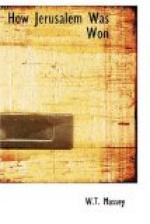The XXth Corps plan was to attack the enemy’s works between the Khalasa road and the wadi Saba with the 60th and 74th Divisions, while the defences north of the wadi Saba were to be masked by the Imperial Camel Corps Brigade and two battalions of the 53rd Division, the remainder of the latter division protecting the left flank of the Corps from any attack by enemy troops who might move south from the Sheria area. The first objective was a hill marked on the map as ‘1070,’ about 6000 yards south-west of Beersheba. It was a prominent feature, 500 yards or perhaps a little more from a portion of the enemy’s main line, and the Turks held it strongly and were supported by a section of German machine-gunners. We had to win this height in order to get good observation of the enemy’s main line of works, and to allow of the advance of field artillery within wire-cutting range of an elaborate system of works protecting Beersheba from an advance from the west. At six the guns began to bombard 1070, and the volume of fire concentrated on that spot must have given the Turks a big surprise. On a front of 4500 yards we had in action seventy-six 18-pounders, twenty 4.5-inch howitzers, and four 3.7-inch howitzers, while eight 60-pounders, eight 6-inch howitzers, and four 4.5-inch howitzers were employed in counter battery work. The absence of wind placed us at a heavy disadvantage. The high explosive shells bursting about the crest of 1070 raised enormous clouds of dust which obscured everything, and after a short while even the flames of exploding shells were entirely hidden from view. The gunners had to stop firing for three-quarters of an hour to allow the dust to settle. They then reopened, and by half-past eight, the wire-cutting being reported completed, an intense bombardment was ordered, under cover of which, and with the assistance of machine-gun fire from aeroplanes, the 181st Infantry Brigade of the 60th Division went forward to the assault. They captured the hill in ten minutes, only sustaining about one hundred casualties, and taking nearly as many prisoners. A German machine-gunner who fell into our hands bemoaned the fact that he had not a weapon left—every one of the machine guns had been knocked out by the artillery, and a number were buried by our fire.
The first phase of the operations having thus ended successfully quite early in the day, the second stage was entered upon. Field guns were rushed forward at the gallop over ground broken by shallow wadis and up and down a very uneven stony surface. The gun teams were generally exposed during the advance and were treated to heavy shrapnel fire, but they swung into action at prearranged points and set about wire-cutting with excellent effect. The first part of the second phase consisted in reducing the enemy’s main line from the Khalasa road to the wadi Saba, though the artillery bombarded the whole line. The 60th Division on the right had two brigades attacking and




